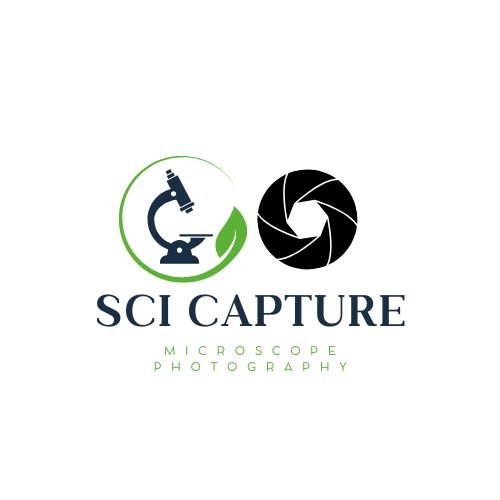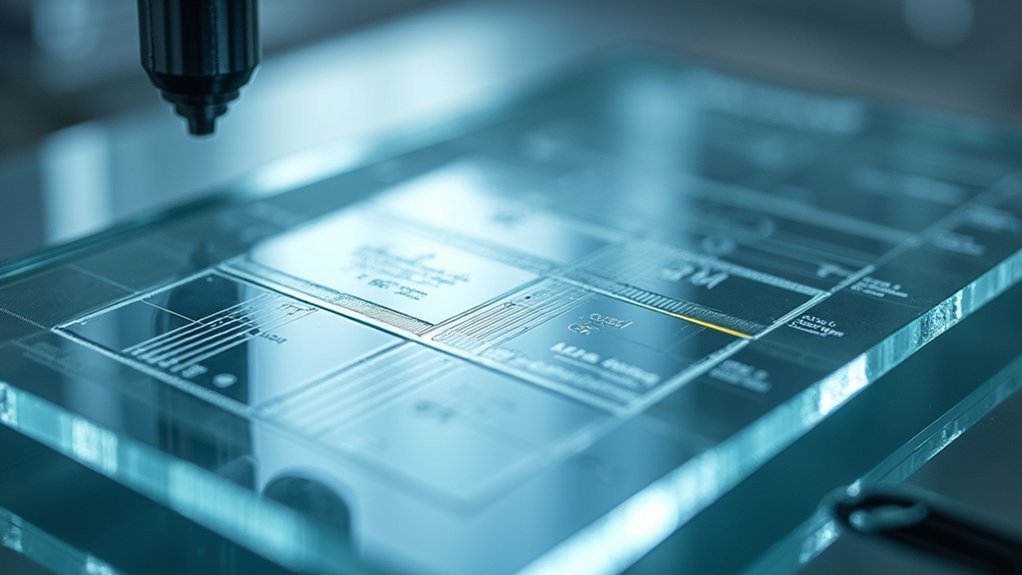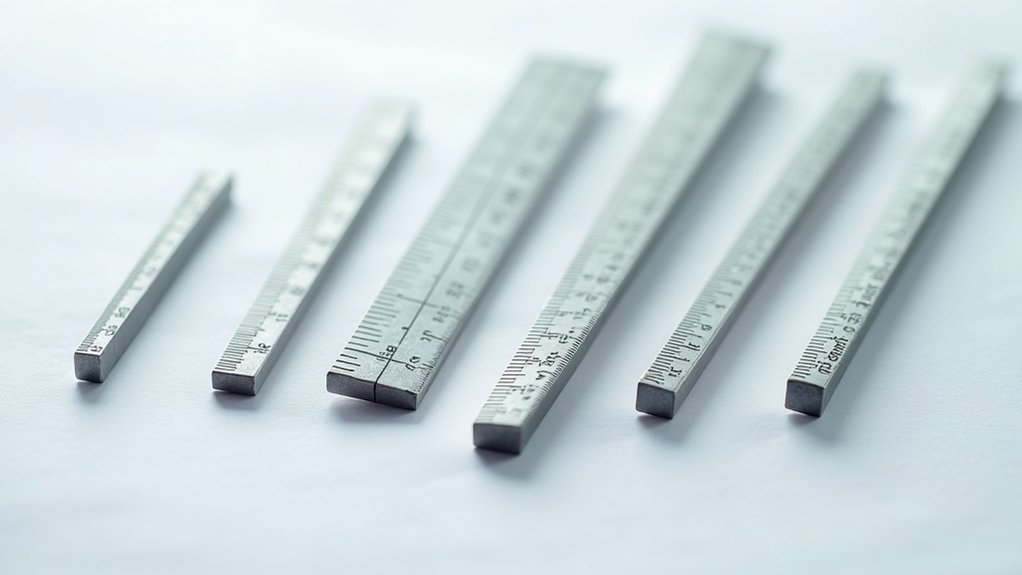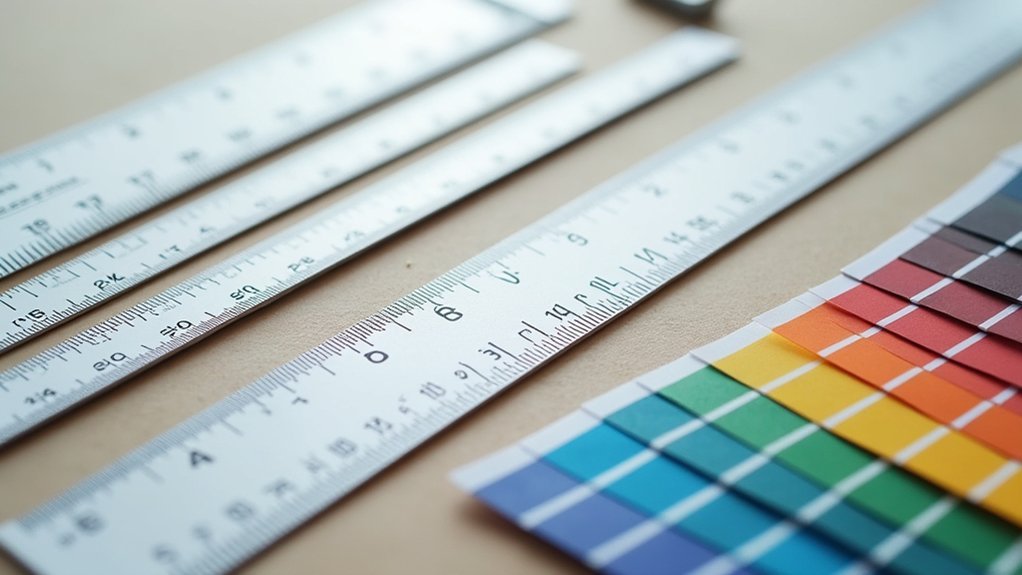For crystal-clear scientific photos, try these pro lighting setups: diffused overhead track lighting with Solux bulbs for color accuracy, cross-polarized lighting to eliminate glare on transparent specimens, multi-angle gooseneck fixtures for dimensional crystal shots, low-heat Solux illumination for heat-sensitive subjects, and gel diffuser techniques for shadow control. Each setup enhances different specimen features while maintaining scientific accuracy. These specialized approaches will transform your technical photography from merely adequate to publication-worthy.
Diffused Overhead Track Lighting for Maximum Detail Capture

Scientists and photographers alike know that capturing specimen details requires specialized lighting. A U-shaped configuration of three black 12-volt ceiling tracks creates an ideal light source for thorough specimen coverage.
You’ll achieve remarkable color accuracy with six Solux 12-volt 50-watt bulbs (100 CRI), which also generate minimal heat—crucial for preserving delicate samples.
Position the goose neck fixtures strategically to eliminate shadows against your black background and highlight intricate specimen features.
Strategic placement of goose neck fixtures eliminates shadows while emphasizing delicate specimen details against the black backdrop.
For professional results, attach gel film diffuser sheets over hose clamps to soften light and reduce glare. The combination of perforated metal shades and black plastic frames effectively dissipates heat while minimizing unwanted reflection.
Most lighting diagrams recommend this setup specifically because it creates the perfect balance of illumination and preservation for scientific photography.
Cross-Polarized Lighting to Eliminate Unwanted Reflections
When photographing specimens with reflective surfaces, you’ll often encounter distracting glare that obscures critical details. Cross-polarized lighting offers a powerful solution by placing polarizing filters in front of both your light source and camera lens to reduce glare dramatically.
This technique works exceptionally well for transparent materials like crystals, where reflections typically hide important features. By rotating the polarizers relative to each other, you can precisely control the level of reflection elimination until you achieve ideal clarity.
Position your light source at an angle to your specimen for best results. You’ll notice cross-polarized lighting doesn’t just remove unwanted reflections—it also helps enhance color saturation and contrast in your images, producing more striking scientific photographs with greater visual information.
This simple setup transforms ordinary documentation into compelling visual data.
Multi-Angle Gooseneck Setup for Dimensional Crystal Photography

Six precisely positioned gooseneck fixtures create the ideal setup for capturing crystals in their full three-dimensional glory. You’ll appreciate how this multi-angle approach maximizes light reflecting from crystal facets, producing images that rival those of a portrait photographer in their depth and clarity.
| Position | Advantage | Technique |
|---|---|---|
| Front | Reveals texture | Use diffuser gel |
| Side | Enhances depth | Bounce light back |
| Rear | Defines edges | Lower intensity |
The U-shaped track configuration guarantees complete coverage while the low-voltage Solux bulbs generate minimal heat, protecting delicate specimens during extended sessions. By attaching diffuser sheets to hose clamps, you’ll soften harsh illumination and reduce glare. This adaptable setup allows you to quickly reposition lights, highlighting intricate crystal details while minimizing shadows.
Low-Heat Solux Illumination for Heat-Sensitive Specimens
For researchers working with heat-sensitive specimens, 12-volt Solux lamps offer a perfect lighting solution that won’t compromise your samples during photography sessions.
With their minimal heat output and ideal 100 CRI rating, these lamps guarantee accurate color representation without thermal damage to delicate materials.
Mount your Solux bulbs in goose neck fixtures for flexible positioning, allowing you to adjust angles while maintaining safe distances from your specimens.
Add perforated metal shades to enhance heat dissipation during extended shoots. For best results, place a white reflector opposite your primary light source to fill shadows and reduce contrast.
Don’t forget to set your camera’s white balance specifically for Solux illumination.
For softer lighting, incorporate gel diffuser sheets—they’ll reduce glare while maintaining the cool environment your heat-sensitive specimens require.
Gel Diffuser Techniques for Shadow Control and Contrast Enhancement

Three essential gel diffuser techniques can transform your scientific photography by eliminating harsh shadows while enhancing specimen detail.
First, place sheets strategically over your lighting fixtures to create even light distribution across your subject. For ideal control, use two layers of diffusers to fine-tune both intensity and color temperature, ensuring accurate specimen representation.
Don’t overlook the importance of framing—adding black plastic around your diffuser frames considerably reduces glare that can obscure critical details.
Remember to maintain flexibility with your lighting positions; subtle adjustments can greatly affect shadow depth and contrast in your final image.
Frequently Asked Questions
How Can I Achieve Proper White Balance Across Mixed Lighting Sources?
To achieve proper white balance across mixed lighting sources, you’ll need to use a gray card to calibrate your camera. Alternatively, you can match color temperatures of all lights or apply selective white balance in post-processing.
What’s the Ideal Working Distance for Macro Photography Lighting Setups?
For macro photography lighting, you’ll typically want a working distance of 4-8 inches. This gives you enough space for lighting placement while maintaining detail. You can adjust based on your specific subject size.
Are DIY Lighting Solutions Effective for Professional Scientific Photography?
DIY lighting solutions can be effective for professional scientific photography if you’re careful about diffusion, color temperature, and consistency. You’ll need to test thoroughly and document your setup for reproducible results.
How Do Light Modifiers Affect Exposure Times for Microscopic Subjects?
Light modifiers reduce available light reaching microscopic subjects, requiring longer exposures. You’ll need to increase exposure times when using diffusers, softboxes, or filters to maintain proper illumination while reducing harsh reflections.
Can Smartphone Cameras Produce Publication-Quality Scientific Photos With Proper Lighting?
You can produce publication-quality scientific photos with smartphones if you’re using proper lighting techniques. Modern phone cameras offer sufficient resolution and quality when paired with appropriate light modifiers and stable mounting systems.
In Summary
You’ve now mastered five professional lighting setups that’ll transform your scientific photography. Whether you’re capturing microscopic details or documenting lab specimens, these techniques will help you produce crystal-clear images with professional results. Experiment with different combinations to find what works best for your specific subjects. Remember, good lighting isn’t just about visibility—it’s about revealing truth in your scientific documentation.





Leave a Reply